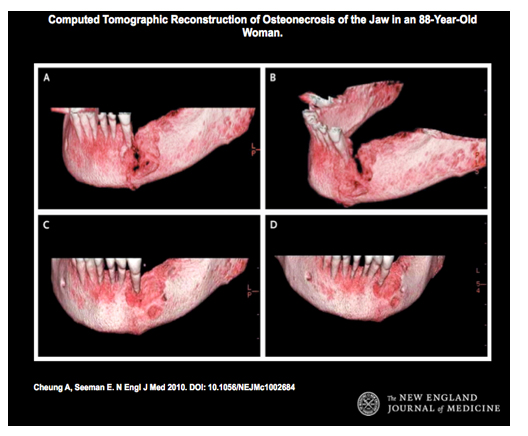| |
Teriparatide Therapy for Alendronate-Associated Osteonecrosis of the Jaw
|
| |
| |
Correspondence
NEJM, October 16, 2010 (10.1056/NEJMc1002684)
To the Editor:
An 88-year-old woman presented to our clinic with a 12-month history of pain, suppuration, and failed healing of a mandibular socket after tooth extraction, despite debridement and the administration of antibiotics. Computed tomographic imaging revealed necrosis of the left mandible consistent with the diagnosis of osteonecrosis of the jaw (Figure 1A and 1BFigure 1Computed Tomographic Reconstruction of Osteonecrosis of the Jaw in an 88-Year-Old Woman.). For 20 years, the patient had been taking prednisolone (at a dose of 5 mg per day) for the treatment of asthma. After a hip fracture 10 years earlier, she had begun taking 70 mg of alendronate per week, along with daily calcium carbonate (1500 mg) and cholecalciferol (25 μg).
The patient provided written informed consent for off-label therapy with subcutaneous teriparatide (recombinant human parathyroid hormone 1-34) at a dose of 20 μg per day. After 8 weeks of treatment, her symptoms resolved, with healing of the osteonecrosis (Figure 1C and 1D).
Figure 1. Computed Tomographic Reconstruction of Osteonecrosis of the Jaw in an 88-Year-Old Woman. Shown is the mandible of a patient with osteonecrosis of the jaw before treatment with teriparatide (Panels A and B) and after 8 weeks of treatment with the drug, which was associated with bone repair (Panels C and D).

Osteonecrosis of the jaw is a rare and debilitating chronic illness. Although a causal relationship between this condition and bisphosphonate therapy remains unproven, the rare association with prolonged bisphosphonate therapy and one report in a patient with laryngeal and prostate cancer who was treated with anti-RANK ligand therapy (denosumab) have implicated suppression of bone remodeling or an alteration in T-cell function in the pathogenesis.1
Bisphosphonates may contribute to osteonecrosis in several ways. First, since bone remodeling removes old or damaged bone and replaces it with new bone, the suppression of remodeling may reduce damage repair after dental extraction. Second, bisphosphonates stimulate the production of γδ T cells, which promote and sustain cytokine-mediated inflammation.2 Third, bisphosphonates may reduce the production of endothelial growth factors and potentially produce mucosal toxicity by their local release. Long-term corticosteroid therapy may also contribute to osteonecrosis by reducing bone formation.
Teriparatide may counteract these mechanisms by stimulating bone remodeling. An increased number of remodeling units and increased bone formation within each unit may promote healing and the removal of damaged bone. In addition, bone necrosis and infection trigger T-cell immune responses, stimulating the secretion of Wnt10b and Wnt-mediated bone formation locally. Teriparatide may augment this process by stimulating marrow CD8+ T cells to produce Wnt10b.3 Additional stimulation of Wnt signaling through the action of teriparatide on sclerostin may further enhance this reparative pathway.
Teriparatide is contraindicated in patients with osteosarcoma or metastatic bone disease, the group in which bisphosphonate-associated osteonecrosis of the jaw is most commonly observed. The resolution of osteonecrosis with teriparatide in our patient and in two previously published case reports4,5 may be fortuitous. However, the rapidity of response and the contrasting cellular- and tissue-level effects of bisphosphonates and teriparatide suggest that a rigorous evaluation of teriparatide in a randomized, controlled study would be of interest in patients with osteonecrosis of the jaw who have been taking bisphosphonates.
Ada Cheung, M.B., B.S.
Ego Seeman, M.D.
Austin Health, Melbourne, VIC, Australia
adac@unimelb.edu.au
| |
| |
| |
|
|
|